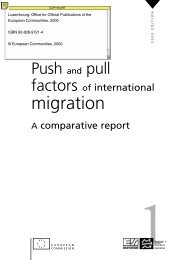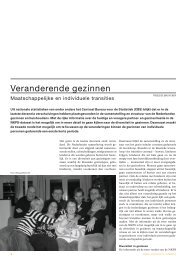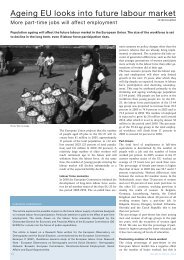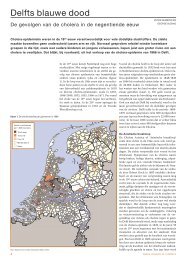adjustments and reactions are the so-called ‘period effects’. These two effects, together withthe physiological effect <strong>of</strong> aging, the social influence <strong>of</strong> family members and peers, and lifecycle circumstances, largely determine the overall outcome. But the study <strong>of</strong> period effectsdoes by no means imply that only period measures should be used. When examining cohortpr<strong>of</strong>iles, a given period related ‘shock’ <strong>of</strong> any importance will show up for all cohorts, butat different ages, and in the instance <strong>of</strong> cohort-period interaction, the magnitude <strong>of</strong> the effect<strong>of</strong> the ‘shock’ will vary according to the life cycle stage <strong>of</strong> each cohort. The breakthrough <strong>of</strong>hormonal contraception during the late 1960 s and 1970 s only affected the stopping behavior<strong>of</strong> older women, whereas it affected the entire fertile life span <strong>of</strong> the younger ones, therebyopening up the possibility for a massive postponement <strong>of</strong> first births. In other words, periodshocks are best studied by assessing their differentiated effect at the various ages and lifecycle stages <strong>of</strong> each <strong>of</strong> the successive cohorts. One does not at all need period measures <strong>of</strong>demographic events to do that finer work.This throws us back to period measures and their use. Period measures are synthetic measuresthat are summations <strong>of</strong> slices <strong>of</strong> the life cycle unfolding <strong>of</strong> different cohorts. Fertility, nuptialityor mortality experiences over a short period <strong>of</strong> time are just summed up to arrive at a finalproduct which is not representative for any <strong>of</strong> the contributing cohorts. These measures haveno meaning in real life. 2 The only exception is <strong>of</strong> course that <strong>of</strong> perfect stationarity. In fact,to give these period measures any meaning, the stationarity condition –i.e. the hypothesis<strong>of</strong> a frozen society in which cohorts are mere copies <strong>of</strong> each other– is absolutely essential.Incidentally, this not only pertains to the Total Fertility Rate and to the Singulate MeanAge at Marriage (SMAM) 3 , but also to all the indirectly standardized ‘Princeton measures’(i.e. Coale’s Ig, Im, Ih or If). All these are frequently used measures, because they providesummaries. But only quick and dirty ones. In fact, period measures are merely accountancytricks for impatient users. Indeed, to get an idea <strong>of</strong> a final intensity 4 , one has to be patient andwait till a certain age is reached by which most <strong>of</strong> the events have occurred. 5 But nothing willprevent us from measuring the events up to an earlier point (defined by either age or duration)to see where successive cohorts had arrived by that point. One way <strong>of</strong> doing this is to take a2It could be argued that Kuczynski’s gross and net reproduction rates (GRR and NRR) were major historical stepsforward. But these period measures and especially the NRR led very illustrious demographers down the garden pathand into the belief that Europe was going to die out. Despite the fact that the Lexis diagram was long known by the1930 s , the impact <strong>of</strong> a tempo shift was totally ignored, together with cohort analyses.3The inventor <strong>of</strong> SMAM, John Hajnal, was vividly aware <strong>of</strong> this condition, much more so than many subsequent userswho prefer the blurring effect <strong>of</strong> SMAM over the clean analysis <strong>of</strong> proportions married up to a given age (e.g. 20, 25 or30) at various points in time.4The final intensity <strong>of</strong> mortality is <strong>of</strong> course always unity, and much <strong>of</strong> what is going to be said here pertains to otherdemographic events.5The classic objection to cohort analysis is that pr<strong>of</strong>iles are incomplete. Here this “impatience factor” shows up veryclearly. It goes without saying that all one can do is try to complete the schedules for cohorts that are far enough, andpurely speculate or write scenarios for those that are just starting with the unfolding <strong>of</strong> the life course. Just face the factthat the future is unknown for younger cohorts, but that we can monitor their progress, year after year, with a minimum<strong>of</strong> data requirements.40
enchmark cohort and to study the difference function for other cohorts as measured over ageor duration relative to this benchmark. 6The violations <strong>of</strong> the stationarity condition are the cause <strong>of</strong> all the problems with periodmeasures. This brings us to one major violation <strong>of</strong> the stationarity hypothesis: Tempo shifts.This problem is an old one and already discussed in great detail by our older mentors likeLouis Henry and Norman Ryder. But the idea <strong>of</strong> ‘fixing’ the problem by adjusting periodmeasures for the speed <strong>of</strong> the delay is more novel, and was, as everyone knows, pioneered byJohn Bongaarts and Griffith Feeney. More specifically, these authors measured parity specificperiod total fertility rates, and, in the instance <strong>of</strong> postponement, they inflated these total periodrates by ‘backwardly projecting’ them with the speed <strong>of</strong> postponement, as measured by therate <strong>of</strong> shift in the parity specific mean ages at motherhood. One can easily extend this idea tocorrect the total period first marriage rate, and calculations would be simpler too, since a firstmarriage is a non-renewable event. The Bongaarts-Feeney trick led to several variations, butthe core idea is always the same. 7 There are <strong>of</strong> course many problems with such measures.Firstly, how do we measure the speed <strong>of</strong> the tempo shift? Over a single year (very shaky),over five years, or should we opt for a more stable average over a longer time? Furthermore,the values <strong>of</strong> the parity specific TFR s are just period measures and therefore no more thansynthetic measures that are only representative for women <strong>of</strong> a given parity, but irrespective <strong>of</strong>generation. First births occur to teenagers as well as to much older women born twenty yearsearlier. That problem is less acute for birth orders three and higher, but then, the contribution<strong>of</strong> such higher order births has systematically dwindled in all populations <strong>of</strong> the industrializedworld.Secondly, all tempo adjusted measures proposed so far only assume postponement, and donot <strong>of</strong>fer any perspective on subsequent recuperation <strong>of</strong> fertility at later ages. The degree<strong>of</strong> recuperation is <strong>of</strong> course <strong>of</strong> paramount importance as well, and at the later stage <strong>of</strong> theso-called ‘postponement transition’, differential recuperation will determine the degree<strong>of</strong> definitive childlessness and the amount <strong>of</strong> increase in overall period TFR s . A simplesimulation suffices to show how the passage from postponement to recuperation, generationafter generation, will determine the track <strong>of</strong> the summary period measures. In fact, TomasFrejka has provided us with such a simple and elegant simulation <strong>of</strong> generational changes inpostponement and recuperation to illustrate this point. 8 This didactical piece <strong>of</strong> his can alsobe taken as a blueprint to look at real cohort behavior, and to translate that back into periodmeasures. When this is done for a set <strong>of</strong> European populations 9 one realizes furthermore that6This can be done graphically or through a modeling <strong>of</strong> the difference function. For the latest on this issue see TomasSobotka et al., 2011: Postponement and recuperation in cohort fertility: New analytical and projection methods andtheir application. European Demographic Research Papers. Vienna: Vienna Institute <strong>of</strong> Demography, 2.7Add to that the fact that the latest corrections are very data demanding, much more so than that required for a classiccohort analysis.8Tomas Frejka, 2012: The role <strong>of</strong> contemporary childbearing postponement and recuperation in shaping fertility trends.Comparative Population Studies – Zeitschrift für Bevölkerungswissenschaft. Preprint release <strong>of</strong> 27 September 2012.9See Tomas Sobotka et al, op.cit.41
- Page 2 and 3:
- Page 4 and 5: Publication:Nederlands Interdiscipl
- Page 6: Religious and socio-economic determ
- Page 10 and 11: 8IntroductionOn 27 December 2012 Fr
- Page 13: Part IScope and Impact
- Page 17: of further aspects of marriage, div
- Page 20 and 21: ever-changing societal and normativ
- Page 22 and 23: supposed ‘quality-quantity trade-
- Page 24 and 25: The impact of a historical demograp
- Page 26 and 27: and theoretical contributions, but
- Page 29 and 30: Part IIData and Methods
- Page 31 and 32: Early in his career, Frans was co-a
- Page 34 and 35: 32Sex ratios in global historical p
- Page 36 and 37: appeared early, as in some southern
- Page 38 and 39: available on female labour in India
- Page 40 and 41: Kurosu, Satomi (1994), Sex ratios a
- Page 44: the extent of fertility recuperatio
- Page 47 and 48: 25 Years of collaboration: The Hist
- Page 49 and 50: Since 1995 numerous volunteers have
- Page 51 and 52: Part IIIFertility and Nuptiality
- Page 53 and 54: Figure 1. GDP per capita, unemploym
- Page 55 and 56: while the GDP continued to grow som
- Page 57 and 58: Map 1. Communities covered by the C
- Page 59 and 60: Above all, our empirical study demo
- Page 61 and 62: The proportion of consanguineous ma
- Page 63 and 64: Earlier studies have shown that par
- Page 65 and 66: Verzuiling (‘pillarisation’), o
- Page 67: The crumbling of the Roman Catholic
- Page 70 and 71: In the 1970 s , exemption from serv
- Page 72 and 73: DataTo examine this issue, I use da
- Page 74 and 75: ConclusionThese results confirm the
- Page 76 and 77: confirmed for one dependent variabl
- Page 78 and 79: ReferencesBlau, Peter M. and Otis D
- Page 80 and 81: 78Origins of the ‘western Europea
- Page 82 and 83: ReferencesGoldberg, P.J.P. (1992),
- Page 84 and 85: Figure 1. Fertility, mortality, and
- Page 86 and 87: century Nakahara. 1 Nevertheless, i
- Page 88 and 89: 86Are we getting sick of low income
- Page 91 and 92: Neither alone nor neglected:The eld
- Page 93 and 94:
Figure 3. Percentage widowers cores
- Page 95 and 96:
Spouse n.i. n.i. n.i.absent 0,50 1
- Page 97 and 98:
Childbearing and longevity - the co
- Page 100 and 101:
98Excess mortality during the Dutch
- Page 102 and 103:
Table 1. Available vital statistics
- Page 104 and 105:
Mededeelingenvan het bureauvoor sta
- Page 106 and 107:
gender, and in selected age groups
- Page 108 and 109:
Divergence of life expectancy and t
- Page 110 and 111:
a. MenTable 1. Variation in life ex
- Page 112 and 113:
absolute terms current disparities
- Page 114 and 115:
ReferencesLeon, D.A., V.M. Shkolnik
- Page 116 and 117:
climate change and secondly, that t
- Page 118 and 119:
Browning, Christopher R., Danielle
- Page 120 and 121:
populations where life expectancy a
- Page 122 and 123:
120Demographic systems and populati
- Page 125 and 126:
The impact of the 1911 heat wave on
- Page 127 and 128:
in the effect of heat on mortality.
- Page 129 and 130:
ReferencesCapellmann, Carl (1877),
- Page 131 and 132:
Biography of the authorsGeorge Alte
- Page 133 and 134:
Jan Kok (1959) studied social histo
- Page 135 and 136:
His thesis, published in 1997 as AA












